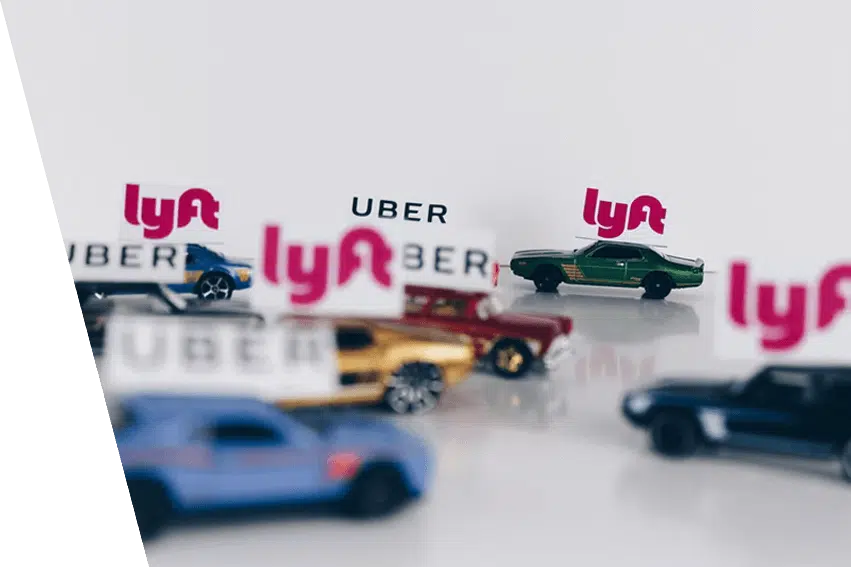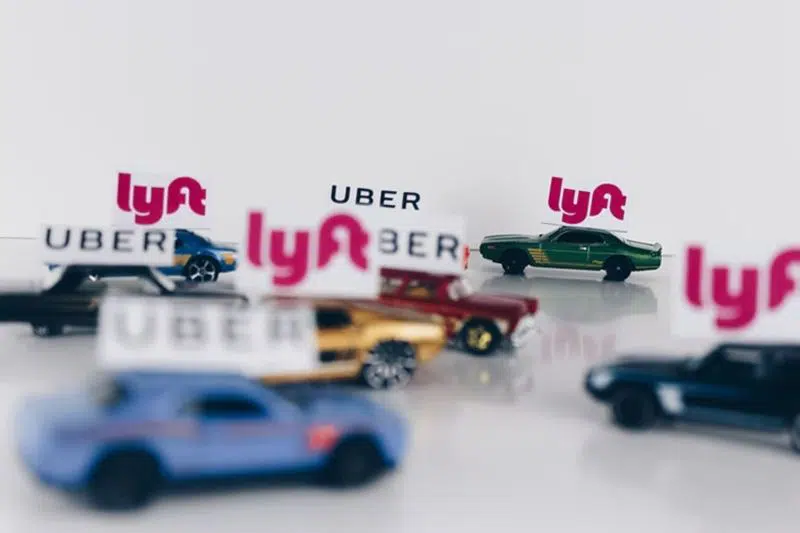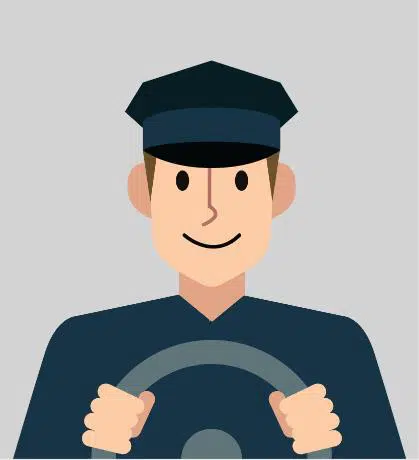Rideshare Sexual Assault
In the past years, ride-sharing apps have exploded in use and popularity. However, with the influx of this technology, ride-sharing apps have created a perfect environment for sexual predators to prey on unassuming individuals. This comprehensive guide discusses the prevalence of sexual assault in rideshare apps, uber sexual assault lawsuits and legal action against major ride-sharing platforms, and safety measures that Lyft and Uber passengers can take to avoid unwanted sexual contact.



Why does Rideshare Sexual Assault Happen?
Ride-sharing has become a very popular and safe way to avoid driving under the influence of drugs or alcohol. Unfortunately, when you’re under the influence of drugs or alcohol, you become more vulnerable to sexual assault by a rideshare driver or by a sexual predator posing as a rideshare driver.
Although rideshare companies such as Lyft and Uber screen their applicants’ criminal histories and driving records, the screening process does not adequately eliminate all sexual predators. Furthermore, some drivers do not receive adequate training about sexual assault, sexual misconduct, and sexual harassment. Additionally, most rideshare companies have failed to implement essential safety protocols that are used by taxi drivers, such as passenger dividers and cameras. This has unfortunately led to reports of rape and sexual assault by drivers of rideshare companies in recent years.
Uber/Lyft Sexual Assault Statistics
and Reports
In a 2019 news story by National Public Radio, a new report showed that Uber received almost 6,000 assault claims in the prior two years. In its first safety report update released in early December 2019, Uber noted that it had reports of 3,045 sexual assaults, 9 murders, and 58 crashes in rides in the United States in 2018. The reported victims included both passengers and drivers. Also, the reported numbers are probably lower than the actual numbers because victims often don’t report sexual assaults.
After Uber released its report, the California Public Utilities Commission fined Uber $59 million for refusing to share the names and contact information of victims of the 3,000 reported sexual assaults, due to various privacy concerns. In July 2021, under a preliminary agreement, Uber negotiated the fine down to $150,000. Under the agreement, Uber is not required to give victims’ names to the Commission but agrees to give out anonymous data about Uber sexual assaults on its website. The preliminary agreement also requires Uber to donate $4 million to the California Victim Compensation Board and donate another $5 million to address sexual assault and safety concerns in the ride-sharing industry. The agreement would also allow Uber riders to opt in to being contacted by California law enforcement when they report a sexual assault. This opt-in feature would apply to all rideshare companies.


As of June 2021, Lyft had still not disclosed its reports of sexual assault incidents, despite pledging to do so three years ago. In March 2021, Lyft blamed the delay on the victims’ privacy issue between Uber and the California Public Utilities Commission. Lyft also stated that the company is waiting on government traffic fatality data to be released before releasing its report. Meanwhile, at least 72 Lyft passengers have filed lawsuits against the ride-sharing company based on its negligent handling of reports of sexual assault and rape, with some cases claiming that Lyft knew that some of its drivers were sexually assaulting passengers but did nothing to stop it.

Tips to Help You Stay Safe and Reduce
Sexual Assault in Ubers and Lyfts
- Uber’s safety tips include waiting inside a safe place until your ride shows up;
- making sure that the rider’s information on Uber matches the person who has arrived before you get into the vehicle, including the car’s make and model and license plate;
- asking the driver to confirm your name before getting into the vehicle;
- riding in the back seat;
- wearing your seat belt;
- and sharing your travel plans with a friend or family member.
If you are going out with a group of women, stick together and employ a buddy system. Make a plan with others in advance about how long you will stay out and whether someone may be going home early. Always make sure that anyone who leaves first, leaves safely. Walk them to their rideshare and make sure they’re getting into the right car, especially if they’re intoxicated. Ensure the make, model, license plate, and driver’s photo match the information on the Uber or Lyft app. Tell your friend to text or give you a phone call to let you know they’ve arrived home safely.
Above all, it’s imperative to trust your gut with any potential safety incident. Our intuitions are very powerful and often accurate. If you sense danger in any way, do not get in the car and do not let your friend get in the car.
As a rideshare passenger, there are some critical steps you can take to keep yourself safe—both Uber and Lyft list these basic safety measures on their websites.
- Uber’s safety tips include waiting inside a safe place until your ride shows up;
- making sure that the rider’s information on Uber matches the person who has arrived before you get into the vehicle, including the car’s make and model and license plate;
- asking the driver to confirm your name before getting into the vehicle;
- riding in the back seat;
- wearing your seat belt;
- and sharing your travel plans with a friend or family member.
Because women are more likely to be victims of sexual assault than men, there are some essential steps that women should take to protect themselves and other women. First, pay attention to your friends’ cues. Notice whether they look uncomfortable and ask them if they’re alright. Next, if you see anyone acting aggressively towards a woman, notify the police or call security immediately.
If you are going out with a group of women, stick together and employ a buddy system. Make a plan with others in advance about how long you will stay out and whether someone may be going home early. Always make sure that anyone who leaves first, leaves safely. Walk them to their rideshare and make sure they’re getting into the right car, especially if they’re intoxicated. Ensure the make, model, license plate, and driver’s photo match the information on the Uber or Lyft app. Tell your friend to text or give you a phone call to let you know they’ve arrived home safely.
Above all, it’s imperative to trust your gut with any potential safety incident. Our intuitions are very powerful and often accurate. If you sense danger in any way, do not get in the car and do not let your friend get in the car.
What Does Uber & Lyft Do and
Is It Enough?
When accepting Lyft or Uber rides, passengers trust that these rideshare companies have done thorough background checks on drivers to ensure that these independent contractors are honest and safe. Rideshare companies do screen all drivers by confirming their identity and personal information through driver’s licenses and real-time photos, and they perform criminal background checks before contracting a driver for work. Background searches include a nationwide search of county court records, federal criminal records, and sex offender registries. Rideshare companies also monitor drivers on an annual basis for new criminal and driving offenses.
In addition, rideshare companies have their in-app safety services. Lyft’s service has in-app safety features, including a feature in which riders can share their location with friends and family. Riders can also connect with an ADT security professional through texting or calling. The ADT security professional can then take the important step of silently alerting 911 and sharing the driver’s location with the police. Lyft also has a 24-hour Critical Response Line, which Lyft drivers and riders can use to report incidents of physical injuries, indecent exposure, and serious sexual assaults. Very similar to Lyft, Uber has an in-app Emergency Button in the app’s Safety Toolkit, which contacts 911. The app shows the rider’s location, vehicle information, and license plate number, which 911 services can then use to locate the vehicle.
However, the fact that sexual assault statistics are high, despite the screenings, means that there is much room for improvement. In some lawsuits brought against Uber and Lyft, alleged victims have argued that the companies’ background screening procedures are inadequate and done at minimal cost, resulting in the companies’ failure to screen out sexual predators. Furthermore, Uber and Lyft’s in-app safety features, such as the ADT feature, only protect against assaults if help arrives quickly before any assault occurs. Furthermore, even if a rider sounds the alarm and gets out of the car, the driver may continue to drive for the rideshare company. Critics of rideshare companies claim that they have allowed problem drivers to continue working because of the companies’ poor record-keeping or because predator drivers may have changed their names.
Uber and Lyft have both taken steps to improve safety and reduce sexual assaults. Uber recently instructed drivers to start registering their dashcams with the company. Uber also encourages victims of sexual assault to bring civil lawsuits against the person who committed sexual assault. Moreover, Uber no longer requires arbitration in sexual assault cases and similar cases.
In 2019, Lyft collaborated with RAINN, an anti-sexual violence organization, to institute a safety education program. All Lyft drivers are now required to complete the program to drive for Lyft.
Still, rideshare companies could further improve their safety by taking several measures. First, they could improve safety by requiring drivers to install dividers between the front and back seats to decrease the risk of physical assaults by both drivers and passengers. They could also require drivers to keep cameras in their cars to monitor each ride. Rideshare companies can also take more action on reported assaults, including being more transparent in disclosing assault statistics. Finally, rideshare companies need to become better at screening out sexual predators.
Understanding the Risks of
Ride Sharing
Ride-sharing is a convenient and relatively inexpensive way to travel, as well as a safe alternative to driving while intoxicated. However, ride-sharing also carries the risk of sexual assault, particularly for women. Although ride-sharing companies like Uber and Lyft claim to vet their drivers to eliminate all sexual predators carefully, statistics prove otherwise. In addition to the risk of sexual assault, one may be getting into a car with a driver with negligent or reckless driving skills. Unfortunately, ride-sharing companies often don’t adequately vet drivers for proper driving skills.


Safety for Students
Ride-sharing is particularly common at universities and colleges, where many students don’t have cars and use ride-sharing to get everywhere. Unfortunately, because of the sheer volume of riders and the fact that young people tend to binge drink and use drugs more than older people, college students, and particularly women, are especially susceptible to being sexually assaulted while ride-sharing.
In April 2021, an Uber driver was sentenced to more than 50 years in prison after being found guilty of rape, sexual assault, and grand theft charges. Between July 2017 and January 2018, Alfonso Alarcon-Nunez preyed on and assaulted five women, four of which were college students in the San Luis Obispo area. Alarcon-Nunez would target intoxicated female riders by sexually assaulting them, stealing their valuables, and then charging them excessive fees for the ride-sharing.
Many college students contact a ride-sharing company late at night after they’ve been drinking alcohol, so their judgment and situational awareness are reduced. In this state, they may be more susceptible to getting into a car without first making sure that it’s a legitimate Uber or Lyft driver. Sexual predators know this, so they often pose as Uber and Lyft drivers and frequent college campuses searching for victims. In a horrific story from a 2019 police report, a University of South Carolina student left a bar in Columbia, South Carolina, at 2 a.m. and got into a car with someone she thought was an Uber driver. She was found murdered the next day. The suspect, Nathanial Rowland, was charged with kidnapping, murder, and possession of a weapon during the commission of a crime. His criminal case trial began in July 2021.
As a Driver - Signs to Look out for to Ensure Sexual Assault is Not Happening

Human trafficking is defined as “the practice of exploiting adults and children for use as commodities, or objects, in conditions of sexual and labor servitude.” Human trafficking is a significant worldwide problem, and it’s estimated that 24.9 million people are victims of human trafficking each year, with girls and women accounting for more than 70% of all victims. The most common form of human trafficking is sexual exploitation.
If you are a ride-sharing driver, it’s essential to be on the lookout for signs of human trafficking or that your passenger may not be traveling according to their own will. If numerous people get into your vehicle, watch for any passenger who appears to be in a state where they cannot make rational decisions or where they are being taken somewhere without their consent. Uber’s website lists specific signs of human trafficking for drivers to look out for, including if the rider appears distressed, disoriented, lost, or fearful; if the rider has any physical signs of abuse or branding, including tattoos that say things like “property of Daddy,” or “for sale,” or anything else that indicates ownership; if the rider appears to have been denied food or water, or has poor hygiene; or if another passenger appears to be exerting power over the rider, such as grabbing their arm, giving them an intimidating or threatening look, or shoving them into the Lyft or Uber cars.

The Uber website also notes that most human trafficking occurs at hotels or transportation hubs. Children may be victims of human trafficking if they’re being dropped off or picked up at places that appear to be unsafe for children. People who have multiple phones or excessive cash may be involved in human trafficking.
If you, as a driver, see anything that makes you suspect human trafficking, it’s essential to report it immediately. One way to report is to contact the National Human Trafficking Hotline at 1-800-373-7888 or text “Help” to 233733.
In addition to looking out for human trafficking, there are several steps drivers should take in any situation where a rider appears to be intoxicated, including helping them find a friend, alerting security or staff that the rider may need help, or contacting law enforcement. If the rider is not responsive, do not touch them. If they appear to need medical attention, call emergency personnel. If the rider’s companion is acting suspicious and coercing the rider to go with them, you can intervene by asking the rider if they want you to contact a friend for them or by contacting law enforcement.
Finally, drivers have the same rights as their riders to feel safe during a ride. If a rider is making you feel uncomfortable for any reason, it is your right to tell them to stop. If you feel you are in danger, you should contact law enforcement. You should also report the incident through both the Uber and Lyft apps.
Uber’s Community Guidelines/Lyft Community Guidelines
Uber and Lyft both provide their community guidelines on their websites. The community guidelines set forth policies for both riders and drivers. Uber’s community guidelines were “developed to help make every experience feel safe and respectful.” Under Uber’s community guidelines, engaging in the following may result in the loss of your Uber account:
- Drug use and open containers
- Discriminating against someone based on various traits, such as age, race, color, religion, sexual orientation, disability, and gender
- Sexual assault or misconduct
- Refusing a rider a trip because of the use of a service animal
- Using Uber to commit a crime
- Engaging in threatening and rude behavior
- Committing fraud, such as charging excessive fees
- Account sharing
- Providing inaccurate vehicle information
- Having sex in an Uber, and
- Contacting a rider after the Uber trip ends.
Also, riders under 18 must be accompanied by an adult. Uber monitors for violations of its community guidelines by reviewing reports submitted by customers and by other means.
Lyft’s community guidelines emphasize choosing kindness, putting safety first, and speaking up with honest ratings and feedback. Like Uber, Lyft’s community guidelines require respecting others’ personal boundaries, and they prohibit the sexual activity, alcohol, and illegal drugs during rideshares. The guidelines also require drivers to allow the use of service animals. Lyft also encourages honest feedback, including reporting all alleged incidents to keep the experience safe for everyone.
What Should You Do If You’re A
Sexual Assault Victim in a Rideshare?
If you have been sexually assaulted while using a ride-sharing service, you should report it immediately. Victims of sexual assault sometimes feel traumatized twice—first, by the initial assault, and then, again, by the unfair treatment, they may receive after reporting the assault. Regardless of the circumstances, a sexual assault is never your fault, and you have the right to report it and obtain justice for what your attacker did to you.
You can report your assault in numerous ways, including through the National Sexual Assault Hotline, at 1-800-656-HOPE, and by contacting law enforcement. Uber and Lyft both have strict policies against sexual assault, and they encourage reporting on the websites. Both the Uber and Lyft apps have reporting features and phone numbers for reporting all incidents of sexual assault, harassment, or misconduct.
If you are a victim of a sexual assault while ride-sharing, you have the right to seek justice for your injuries by filing a civil lawsuit against the person who assaulted you and potentially against the rideshare company as well.


Examples of Sexual Assault in an Uber/Lyft
Examples of sexual assaults by ride-sharing drivers include:
- Attempted or completed rape
- Sexual battery
- Fondling or unwanted touching of a sexual body part
- Forcing a victim to perform unwanted sexual acts, and
- Any other sexual misconduct.
Sexual misconduct can also include non-physical conduct, such as:
- Unwanted sexual advances
- Obscene messages or invitations
- Staring or leering sexually
- Catcalling
- Unwanted sharing of sexually suggestive pictures
- Verbal comments such as sexual jokes
- Profane or derogatory comments, and
- Comments about a person’s physical appearance.
How Long Do I Have To File An
Uber Assault Lawsuit?
A rideshare sexual assault lawsuit is considered a type of personal injury lawsuit. Each state has its sexual assault deadline, known as a statute of limitations, for making a civil complaint. Most states’ personal injury statutes of limitations range from two to five years. As soon as possible after any sexual assault, it is vital to contact an attorney who has experience with ride-sharing sexual assault claims. The attorney will know what the deadlines are for filing a personal injury lawsuit in your state. The attorney can give you legal advice about when you should bring a suit and who you should sue. Liable parties could include the person who assaulted you as well as the rideshare company if you can show that the company knew or should have known that the driver was dangerous.
The Long-Term Effects of Sexual
Abuse
Sexual abuse is a devastating crime that often brings on feelings of shame in a victim, even though sexual assault is never a victim’s fault. Victims of sexual abuse and sexual violence often suffer long-term effects, including depression, anxiety, substance abuse, difficulties in romantic and sexual relationships, eating disorders, and sleep difficulties.
The abuse victim may re-live the abuse and be triggered by specific situations, causing panic attacks or extreme anxiety. This form of trauma, known as post-traumatic stress disorder, can be particularly debilitating, and sexual abuse victims may need long-term counseling to recover and heal from the sexual abuse. Receiving financial compensation from the liable party can help pay for your recovery.
How to Seek Justice for
Rideshare Sexual Assault?
Our attorneys at Cutter Law have many years of experience in dealing with Uber and Lyft sexual assaults and other allegations of serious sexual assault. Our law firm can offer you important advice about your legal rights and options, and we can help you build your case after a sexual assault.
How To Recognize When Your Family Member/Friend Has Suffered Sexual Assault
Signs of sexual assault can be both physical and emotional. Obvious physical signs of sexual assault include vaginal lacerations, bleeding, or the presence of seminal fluid. Other signs of sexual assault include withdrawing from friends or family, anxiety, being hypervigilant, having trouble sleeping, developing eating disorders, abusing drugs or alcohol, and avoiding activities that used to be enjoyable. If a friend or family member has suffered from sexual assault, it’s imperative to listen to them, tell them you believe them, and emphasize that it was not their fault, no matter what.
Helpful Sexual Assault Resources
If you have been a victim of sexual assault, there are numerous resources available. First, each state maintains its sexual assault hotline or reporting service. Conduct an internet search for your state. You can also contact the National Center for Victims of Crime at 1-844-4VICTIM to learn about your legal rights. Additionally, Safe Horizon is an excellent resource for survivors of domestic violence and victims of rape, abuse, incest, and sexual assault. They maintain a free, 24/7 phone number, at 1-800-621-HOPE, with counselors on call to help. Finally, you can also contact the National Sexual Assault Hotline at 1-800-656-HOPE to report sexual assault.
If you or someone you know was sexually assaulted while using a ride-sharing app, our knowledgeable sexual assault lawyers here at Cutter Law can help you understand your legal rights. Contact us today for a free case evaluation.



